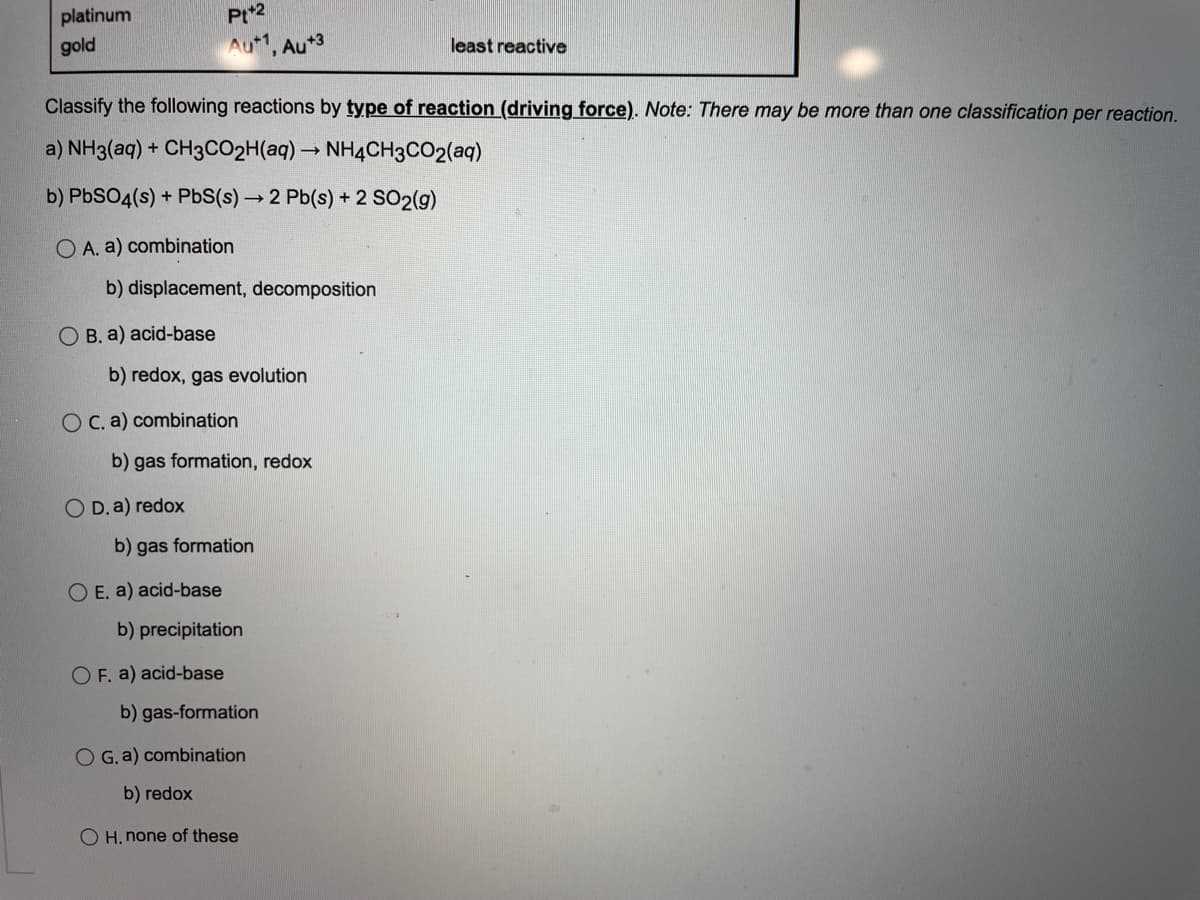Classify the following reactions by type of reaction (driving force). Note: There may be more than one classification per reaction. a) NH3(aq) + CH3CO2H(aq)→ NH4CH3CO2(aq) b) PbSO4(s) + PbS(s)2 Pb(s) + 2 SO2(g) O A. a) combination b) displacement, decomposition O B. a) acid-base b) redox, gas evolution O C. a) combination b) gas formation, redox O D. a) redox b) gas formation O E. a) acid-base b) precipitation O F. a) acid-base b) gas-formation O G, a) combination b) redox O H. none of these
Classify the following reactions by type of reaction (driving force). Note: There may be more than one classification per reaction. a) NH3(aq) + CH3CO2H(aq)→ NH4CH3CO2(aq) b) PbSO4(s) + PbS(s)2 Pb(s) + 2 SO2(g) O A. a) combination b) displacement, decomposition O B. a) acid-base b) redox, gas evolution O C. a) combination b) gas formation, redox O D. a) redox b) gas formation O E. a) acid-base b) precipitation O F. a) acid-base b) gas-formation O G, a) combination b) redox O H. none of these
Chemistry by OpenStax (2015-05-04)
1st Edition
ISBN:9781938168390
Author:Klaus Theopold, Richard H Langley, Paul Flowers, William R. Robinson, Mark Blaser
Publisher:Klaus Theopold, Richard H Langley, Paul Flowers, William R. Robinson, Mark Blaser
Chapter19: Transition Metals And Coordination Chemistry
Section: Chapter Questions
Problem 17E: Predict the products of each of the following reactions. (Note: In addition to using the information...
Related questions
Question
4.4

Transcribed Image Text:platinum
Pt2
gold
Au1, Au*3
least reactive
Classify the following reactions by type of reaction (driving force). Note: There may be more than one classification per reaction.
a) NH3(aq) + CH3CO2H(aq)→ NH4CH3CO2(aq)
b) PbSO4(s) + PbS(s) →2 Pb(s) + 2 SO2(g)
O A. a) combination
b) displacement, decomposition
O B. a) acid-base
b) redox, gas evolution
O C. a) combination
b) gas formation, redox
O D. a) redox
b) gas formation
O E. a) acid-base
b) precipitation
OF. a) acid-base
b) gas-formation
O G, a) combination
b) redox
O H. none of these
Expert Solution
This question has been solved!
Explore an expertly crafted, step-by-step solution for a thorough understanding of key concepts.
This is a popular solution!
Trending now
This is a popular solution!
Step by step
Solved in 4 steps

Knowledge Booster
Learn more about
Need a deep-dive on the concept behind this application? Look no further. Learn more about this topic, chemistry and related others by exploring similar questions and additional content below.Recommended textbooks for you

Chemistry by OpenStax (2015-05-04)
Chemistry
ISBN:
9781938168390
Author:
Klaus Theopold, Richard H Langley, Paul Flowers, William R. Robinson, Mark Blaser
Publisher:
OpenStax

Chemistry & Chemical Reactivity
Chemistry
ISBN:
9781337399074
Author:
John C. Kotz, Paul M. Treichel, John Townsend, David Treichel
Publisher:
Cengage Learning

Chemistry & Chemical Reactivity
Chemistry
ISBN:
9781133949640
Author:
John C. Kotz, Paul M. Treichel, John Townsend, David Treichel
Publisher:
Cengage Learning

Chemistry by OpenStax (2015-05-04)
Chemistry
ISBN:
9781938168390
Author:
Klaus Theopold, Richard H Langley, Paul Flowers, William R. Robinson, Mark Blaser
Publisher:
OpenStax

Chemistry & Chemical Reactivity
Chemistry
ISBN:
9781337399074
Author:
John C. Kotz, Paul M. Treichel, John Townsend, David Treichel
Publisher:
Cengage Learning

Chemistry & Chemical Reactivity
Chemistry
ISBN:
9781133949640
Author:
John C. Kotz, Paul M. Treichel, John Townsend, David Treichel
Publisher:
Cengage Learning

Chemistry for Engineering Students
Chemistry
ISBN:
9781337398909
Author:
Lawrence S. Brown, Tom Holme
Publisher:
Cengage Learning

General Chemistry - Standalone book (MindTap Cour…
Chemistry
ISBN:
9781305580343
Author:
Steven D. Gammon, Ebbing, Darrell Ebbing, Steven D., Darrell; Gammon, Darrell Ebbing; Steven D. Gammon, Darrell D.; Gammon, Ebbing; Steven D. Gammon; Darrell
Publisher:
Cengage Learning
